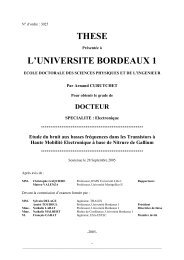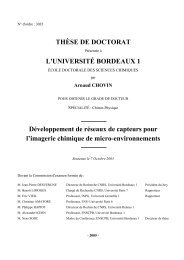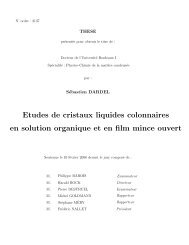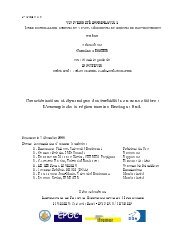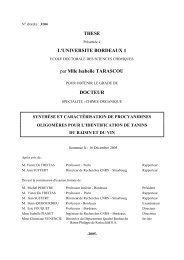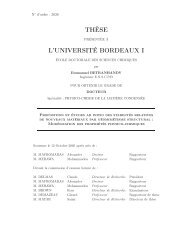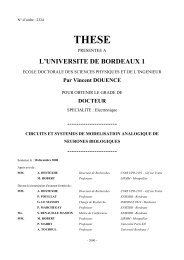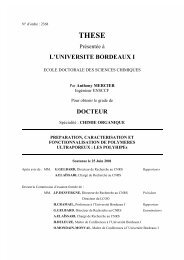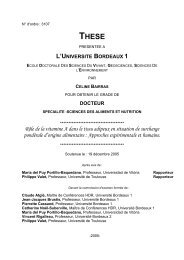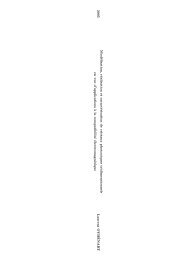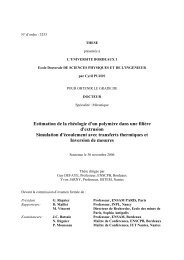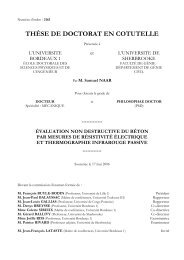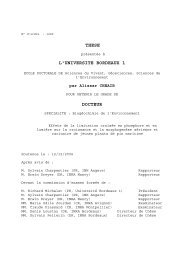- Page 3: Avant proposCe travail de thèse n
- Page 7: Résumé :L’évolution géodynami
- Page 15 and 16: 1.1.1.1. Relief côtier 1821.1.1.2.
- Page 17: Avant -proposCe projet de recherche
- Page 22 and 23: Chapitre 1 : Problématique, object
- Page 24 and 25: Chapitre 1 : Problématique, object
- Page 26 and 27: Chapitre 2 : Méthodologiedes dép
- Page 28 and 29: Chapitre 2 : Méthodologiedébris a
- Page 30 and 31: Chapitre 2 : MéthodologieP2 : 90P3
- Page 32 and 33: Chapitre 2 : MéthodologieT10,50éc
- Page 37 and 38: Chapitre 1 : La subduction, son vol
- Page 39 and 40: Chapitre 1 : La subduction, son vol
- Page 41 and 42: Chapitre 1 : La subduction, son vol
- Page 43 and 44: Chapitre 1 : La subduction, son vol
- Page 45: Chapitre 1 : La subduction, son vol
- Page 49 and 50: Chapitre 1 : La subduction, son vol
- Page 51: Chapitre 1 : La subduction, son vol
- Page 54 and 55: Chapitre 2 : Phase de remplissage d
- Page 56 and 57: Chapitre 2 : Phase de remplissage d
- Page 58 and 59:
Chapitre 2 : Phase de remplissage d
- Page 60 and 61:
Chapitre 2 : Phase de remplissage d
- Page 62 and 63:
Chapitre 2 : Phase de remplissage d
- Page 64 and 65:
Chapitre 2 : Phase de remplissage d
- Page 66 and 67:
Chapitre 2 : Phase de remplissage d
- Page 68 and 69:
Chapitre 2 : Phase de remplissage d
- Page 70 and 71:
Chapitre 2 : Phase de remplissage d
- Page 72 and 73:
Chapitre 2 : Phase de remplissage d
- Page 74 and 75:
Chapitre 2 : Phase de remplissage d
- Page 76 and 77:
Chapitre 2 : Phase de remplissage d
- Page 78:
Chapitre 2 : Phase de remplissage d
- Page 82 and 83:
Chapitre 2 : Phase de remplissage d
- Page 84 and 85:
Chapitre 2 : Phase de remplissage d
- Page 86 and 87:
Chapitre 2 : Phase de remplissage d
- Page 88 and 89:
Chapitre 2 : Phase de remplissage d
- Page 91 and 92:
Chapitre 2 : Phase de remplissage d
- Page 93 and 94:
Chapitre 2 : Phase de remplissage d
- Page 95 and 96:
Chapitre 2 : Phase de remplissage d
- Page 97 and 98:
Chapitre 2 : Phase de remplissage d
- Page 99 and 100:
Chapitre 2 : Phase de remplissage d
- Page 101 and 102:
Chapitre 2 : Phase de remplissage d
- Page 103 and 104:
Chapitre 2 : Phase de remplissage d
- Page 105 and 106:
Chapitre 2 : Phase de remplissage d
- Page 107 and 108:
Chapitre 2 : Phase de remplissage d
- Page 109 and 110:
Chapitre 2 : Phase de remplissage d
- Page 111 and 112:
Chapitre 2 : Phase de remplissage d
- Page 113 and 114:
Chapitre 3 : Exemple d’un bassin
- Page 115 and 116:
Chapitre 3 : Exemple d’un bassin
- Page 117 and 118:
Chapitre 3 : Exemple d’un bassin
- Page 119 and 120:
Chapitre 3 : Exemple d’un bassin
- Page 121 and 122:
Chapitre 3 : Exemple d’un bassin
- Page 123 and 124:
Chapitre 3 : Exemple d’un bassin
- Page 125 and 126:
Chapitre 3 : Exemple d’un bassin
- Page 127 and 128:
Chapitre 3 : Exemple d’un bassin
- Page 129 and 130:
Chapitre 3 : Exemple d’un bassin
- Page 131 and 132:
Chapitre 3 : Exemple d’un bassin
- Page 133 and 134:
Chapitre 3 : Exemple d’un bassin
- Page 135 and 136:
Chapitre 3 : Exemple d’un bassin
- Page 137 and 138:
Chapitre 3 : Exemple d’un bassin
- Page 139 and 140:
Chapitre 3 : Exemple d’un bassin
- Page 141 and 142:
Chapitre 3 : Exemple d’un bassin
- Page 143 and 144:
Chapitre 3 : Exemple d’un bassin
- Page 145 and 146:
Chapitre 3 : Exemple d’un bassin
- Page 147 and 148:
Chapitre 3 : Exemple d’un bassin
- Page 149 and 150:
Chapitre 3 : Exemple d’un bassin
- Page 151 and 152:
Chapitre 3 : Exemple d’un bassin
- Page 153 and 154:
Chapitre 3 : Exemple d’un bassin
- Page 155 and 156:
Chapitre 3 : Exemple d’un bassin
- Page 157 and 158:
Chapitre 3 : Exemple d’un bassin
- Page 159 and 160:
Chapitre 3 : Exemple d’un bassin
- Page 161 and 162:
Chapitre 3 : Exemple d’un bassin
- Page 163 and 164:
Chapitre 3 : Exemple d’un bassin
- Page 165 and 166:
Chapitre 3 : Exemple d’un bassin
- Page 167 and 168:
PARTIE 3 : METHODE ASM APPLIQUEE AU
- Page 169 and 170:
Chapitre 1 : Etude structurale du s
- Page 171 and 172:
Chapitre 1 : Etude structurale du s
- Page 173 and 174:
Chapitre 1 : Etude structurale du s
- Page 175 and 176:
Chapitre 1 : Etude structurale du s
- Page 177 and 178:
Chapitre 1 : Etude structurale du s
- Page 179 and 180:
Chapitre 1 : Etude structurale du s
- Page 181 and 182:
Chapitre 1 : Etude structurale du s
- Page 183 and 184:
Chapitre 1 : Etude structurale du s
- Page 185 and 186:
Chapitre 1 : Etude structurale du s
- Page 187 and 188:
Chapitre 1 : Etude structurale du s
- Page 189 and 190:
PARTIE 4 : ETUDE D’UN POINT DE VU
- Page 191 and 192:
CHAPITRE 1 : ETUDE GEOMORPHOLOGIQUE
- Page 193 and 194:
Chapitre 1 : Etude géomorphologiqu
- Page 195 and 196:
Chapitre 1 : Etude géomorphologiqu
- Page 197 and 198:
Chapitre 1 : Etude géomorphologiqu
- Page 199 and 200:
Chapitre 1 : Etude géomorphologiqu
- Page 201 and 202:
Chapitre 1 : Etude géomorphologiqu
- Page 203 and 204:
Chapitre 1 : Etude géomorphologiqu
- Page 205 and 206:
Chapitre 2 : Etude tectonique de la
- Page 207 and 208:
Chapitre 2 : Etude tectonique de la
- Page 209 and 210:
Chapitre 2 : Etude tectonique de la
- Page 211 and 212:
Chapitre 2 : Etude tectonique de la
- Page 213 and 214:
Chapitre 2 : Etude tectonique de la
- Page 215 and 216:
Chapitre 2 : Etude tectonique de la
- Page 217 and 218:
Chapitre 2 : Etude tectonique de la
- Page 219 and 220:
Chapitre 2 : Etude tectonique de la
- Page 221 and 222:
Chapitre 2 : Etude tectonique de la
- Page 223 and 224:
Chapitre 2 : Etude tectonique de la
- Page 225 and 226:
Chapitre 2 : Etude tectonique de la
- Page 227 and 228:
Chapitre 2 : Etude tectonique de la
- Page 229 and 230:
Chapitre 2 : Etude tectonique de la
- Page 231 and 232:
Chapitre 2 : Etude tectonique de la
- Page 233 and 234:
PARTIE 5 : CONCLUSIONS223
- Page 235 and 236:
Chapitre 1 : Modélisatioin d’un
- Page 237 and 238:
Chapitre 1 : Modélisatioin d’un
- Page 239 and 240:
Chapitre 1 : Modélisatioin d’un
- Page 241 and 242:
Chapitre 1 : Modélisatioin d’un
- Page 243 and 244:
Chapitre 2 : Comparaison avec d’a
- Page 245 and 246:
Chapitre 2 : Comparaison avec d’a
- Page 247 and 248:
Chapitre 3 : PerspectivesCHAPITRE 3
- Page 249 and 250:
Chapitre 3 : Perspectives- affiner
- Page 251 and 252:
BibliographieREFERENCES BIBLIOGRAPH
- Page 253 and 254:
BibliographieBeal, C.H., (1948). Re
- Page 255 and 256:
BibliographieCurray, J.R., et Moore
- Page 257 and 258:
BibliographieFischer, R., Galli-Oli
- Page 259 and 260:
BibliographieGastil, G.R., Krummena
- Page 261 and 262:
BibliographieHelenes, J., et Carre
- Page 263 and 264:
BibliographieLedesma-Vazquez, J. et
- Page 265 and 266:
BibliographieMc Lean, H., Barron, J
- Page 267 and 268:
BibliographieNava-Sanchez, E.H., Cr
- Page 269 and 270:
BibliographiePetitjohn, F.J., Potte
- Page 271 and 272:
BibliographieSawlan, M.G., (1991).
- Page 273 and 274:
BibliographieSmith, J.T., Smith, J.
- Page 275 and 276:
BibliographieSzabo, B.J., B.P. Haus
- Page 277 and 278:
Liste des figuresListe des figuresF
- Page 279 and 280:
Liste des figuresFigure 2.3. 8: Exe
- Page 281:
Liste des tableauxTableau 2.1. 1: C
- Page 284 and 285:
AnnexesImage satellite Landsat de l
- Page 286 and 287:
Annexes4
- Page 288 and 289:
Annexes6
- Page 290 and 291:
Annexes8
- Page 292 and 293:
Annexes10
- Page 294 and 295:
Annexes12
- Page 296 and 297:
Annexes14
- Page 298 and 299:
Annexescoupes 11 (B), 12 (A) et 13
- Page 300 and 301:
AnnexesAssociation de faciès dans
- Page 302 and 303:
Annexes20
- Page 304 and 305:
AnnexesPLANCHE 1Roches Sédimentair
- Page 306 and 307:
AnnexesPLANCHE 2Roches MagmatiquesG
- Page 308 and 309:
AnnexesPLANCHE 3Roches volcanoclast
- Page 310 and 311:
AnnexesPLANCHE 4Roches volcanoclast
- Page 312 and 313:
AnnexesPLANCHE 5Roches volcanoclast
- Page 314 and 315:
AnnexesPLANCHE 6Roches volcanoclast
- Page 316 and 317:
AnnexesPLANCHE 7Roches volcanoclast
- Page 318 and 319:
AnnexesPLANCHE 8Pseudotachylite56.
- Page 320 and 321:
AnnexesPLANCHE 9Pseudotachylite56.
- Page 322 and 323:
Annexes40
- Page 324 and 325:
AnnexesAnalyse sédimentologiqueL
- Page 326 and 327:
Annexes44
- Page 328 and 329:
AnnexesMD02-2509 : Etude des niveau
- Page 330 and 331:
Annexes48
- Page 332 and 333:
AnnexesEchantillons étudiés par A
- Page 334 and 335:
AnnexesRESULTATS ASM IGNIMBRITESite
- Page 336 and 337:
Annexes54
- Page 338 and 339:
AnnexesEXEMPLE de résultats obtenu
- Page 340 and 341:
Annexes58
- Page 342 and 343:
AnnexesEtude du taux d’élévatio
- Page 344 and 345:
Annexes62



